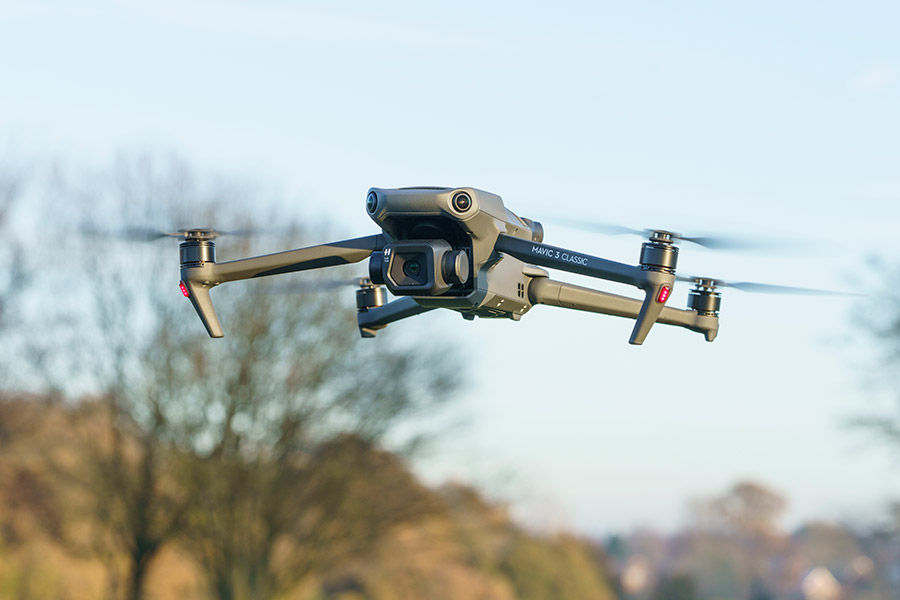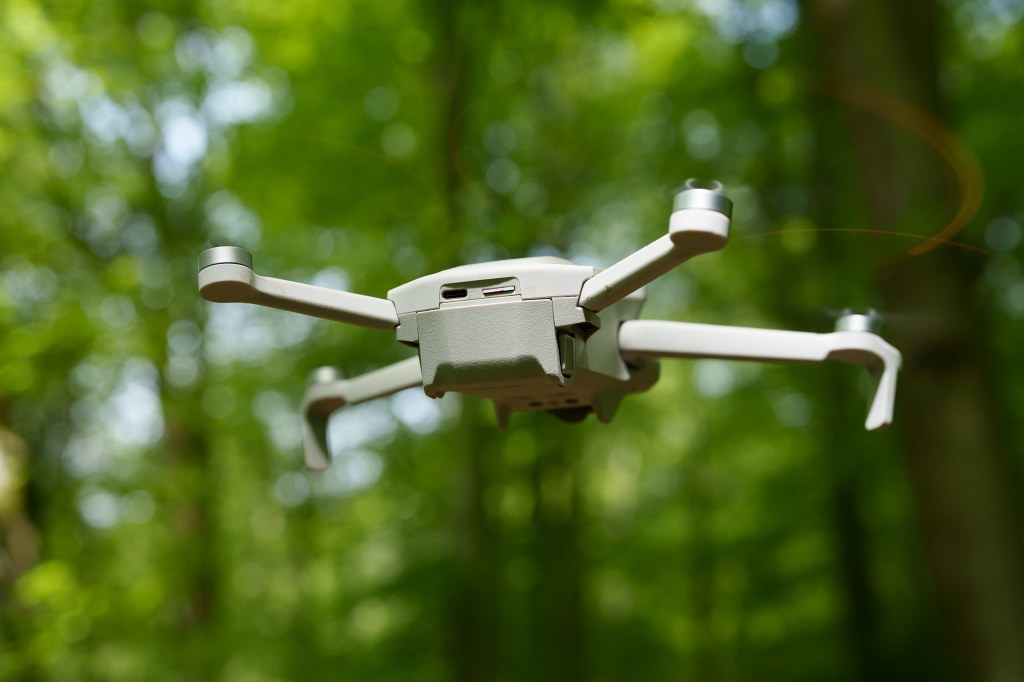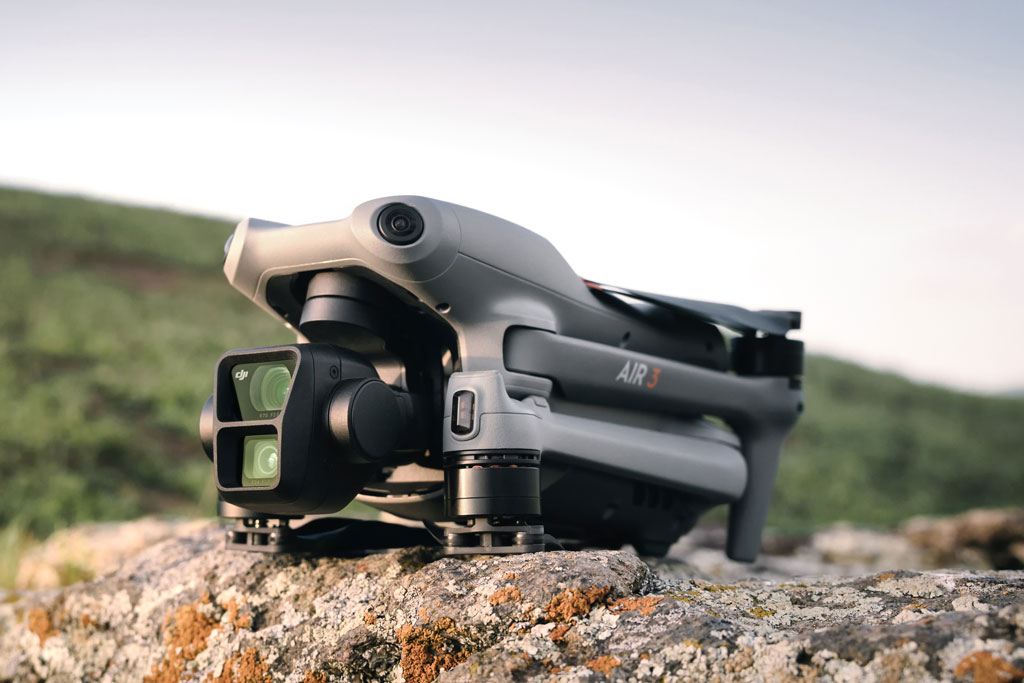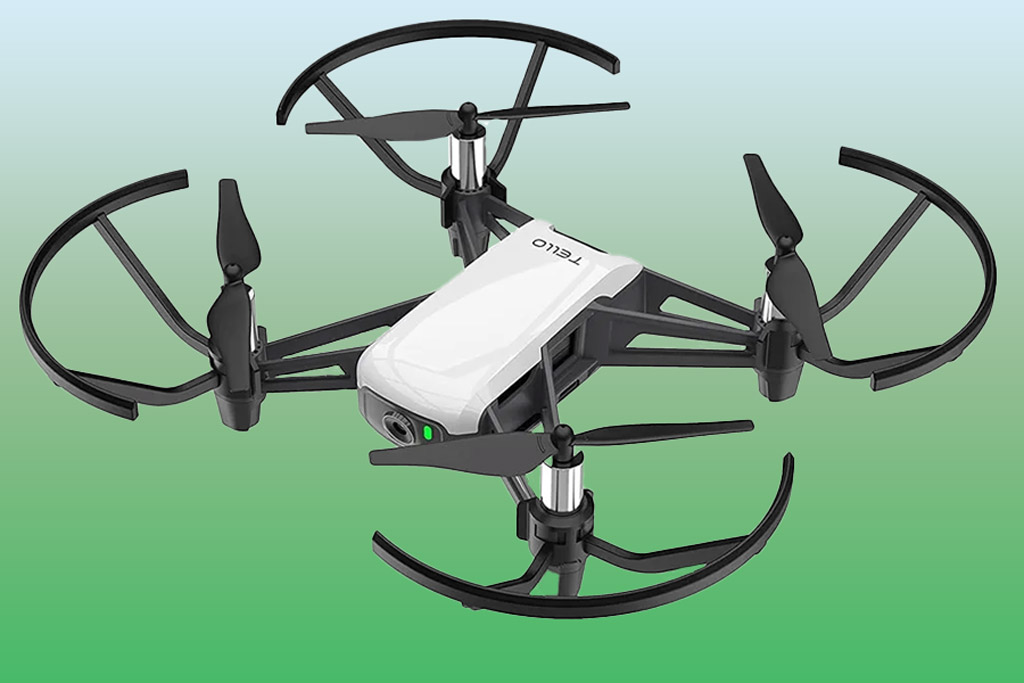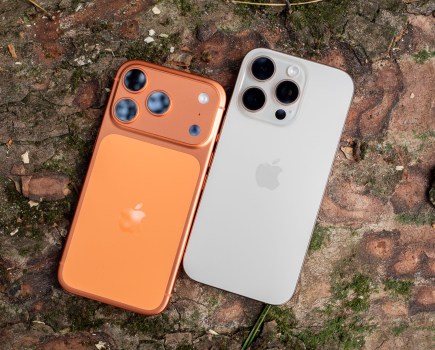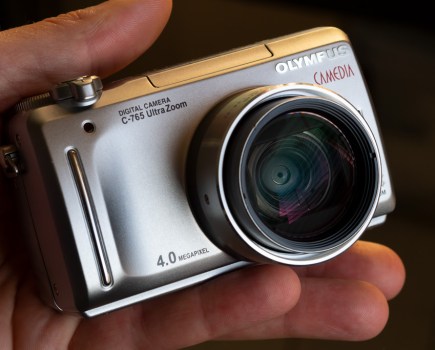The best drones equipped with cameras can capture incredible, dramatic imagery. Be it for stills, video, or both, modern camera drones are stacked with features that make it easier than ever to capture quality content: sophisticated stabilisation systems, high-resolution sensors, intelligent flight features and more. There’s never been a better time to jump into the exciting world of drone photography and filming.
At Amateur Photographer, we take aerial photography as seriously as other types of photography – we put camera drones are put through the same kind of rigorous testing procedures that we do cameras. This list consists of the drones that have truly impressed our review team: and not just the expensive, professional models. With more cheap drones available now than ever, including the impressive new DJI Neo, we put these through their paces just as thoroughly as we do the Mavics of the world.
We’ve included options from market leaders DJI, as well as some other manufacturers to give an overview of what’s out there. You can scroll to the bottom of this page for a primer of the key features of camera drones and some key tips regarding what to look for when buying them — one key thing to remember is to familiarise yourself with the laws and weight restrictions for drones in your area so as not to get caught out.
The best drones with cameras: quick list
If you need to get right to the action, here is a quick rundown of our picks of the best drones with cameras on the market right now, along with links to get the best prices:
- Best camera drone for enthusiast photographers: DJI Mavic 3 Classic – Buy now
- Best camera drone for advanced photographers: DJI Mavic 4 Pro – Buy now
- Best cheap camera drone: DJI Neo – Buy now
- Best sub-250g drone: DJI Mini 4 Pro – Buy now
- Best first drone: DJI Mini 3 – Buy now
- Best mid-range drone: DJI Air 3 – Buy now
- Best toy drone: Ryze Tello – Buy now
Read on to learn more about each of these drones, with insights from our full tests and reviews. And for other cameras suited to outdoor adventures, check out our rundown of the best action cameras…
Why you can trust Amateur Photographer
We spend many hours testing every product we recommend, in detail, in a variety of situations and shooting scenarios, and only use experts for our reviews, so you can be sure that you’re getting the best products. Find out more about our expert writers.
Best drone overall
Best camera drone for enthusiast photographers: DJI Mavic 3 Classic – $1,279 / £1,119
Amateur Photographer verdict
Like all DJI’s recent imaging drones, the Mavic 3 Classic is easy to set up and fly, and seeing the images on the controller screen is bound to put a smile on your face.- Great results from the larger-than-average sensor
- Class 1 classification
- Easy to fly
- The price rises if you want the DJI RC controller
- Requires an understanding of the drone regulations
- Extra batteries advisable
At a glance
- 20MP Four Thirds type
- 24mm (equivalent) f/2.8
- 5.1K video at up to 50p
- Max flight time 46 minutes
- 895g
DJI makes three versions of the Mavic 3, the Standard, the Classic and the Cine version. The Mavic 3 Cine is aimed at filmmakers, the standard Mavic 3 features a wide-angle camera, and a telephoto camera, and this new Mavic 3 Classic does away with the telephoto camera to make a more affordable option. This means it’s most likely going to be more than enough of most enthusiast photographers and videographers.
It features one 20MP 1-inch camera with a 24mm equivalent focal length. There’s 8GB of onboard storage, and this can easily be upgraded using the microSD card slot.
Like almost all the drones in our list, the Mavic 3 Classic folds for easier transport. Its powerful motors means that its very stable in flight and can cope with pretty strong winds. It’s very easy to fly manually but comes with DJI’s suite of automated flying modes to keep things simple.
Read our DJI Mavic 3 Classic review
Best for advanced users
Best camera drone for advanced photographers: DJI Mavic 4 Pro- $2699 / £1780

Amateur Photographer verdict
A major update over it’s predecessor, the Mavic 4 Pro is stable fast and easy to fly while capturing great quality footage.- 100MP Hasselblad main camera
- Unique 360° rotating gimbal
- Up to 51 minutes of flight time
- Pricey Creator Combo
- No ND filters included in the kits
- Regulatory limitations for drones over 250g
At a glance
- Drone with three integrated cameras
- 100MP Hasselblad main camera
- Max video resolution 6K (6016×3384) at 24/25/30/48/50/60fps
- 1063g take-off weight
- 257.6×124.8×106.6 mm (L×W×H) when folded
The Mavic 4 Pro delivers. a huge update over the previous Mavic 3 Pro and features three cameras, a 100MP Quad Bayer Hasselblad sensor and a 360° rotating Infinity Gimbal. But weighing 1063g, it means you will need to hold an A2 Certificate of Competency to fly it within 10m of areas used for recreational, residential, industrial or commercial purposes.
With its heavier body, it provides a robust and steady platform that tackles windier conditions and flies faster, and with DJI’s omnidirectional obstacle detection does an excellent job keeping it out of harm’s way. To help the more advanced camera system and provide longer flight times, there is a bigger battery on board supporting up to 51 minutes of flight time.
The Infinity Gimbal allows you to capture dynamic videos and true portrait orientation stills or video. The cameras on board are similar to the Mavic 3 Pro but with some tweaks. At default resolution it captures 25MP stills (up from 20MP) and thanks to the Hasselblad Quad Bayer technology on board it is able to transform them to 100MP images.
The main camera has a 28mm focal length and a variable f/2.0-f/11 aperture, while the two telephoto cameras at 70mm and 168mm equivalent have fixed f/2.8 apertures. It records video in 6K up to 120fps and supports 10-bit D-Log, D-Log M and HLG recording.
Like all the drones in our list, the Mavic 4 Pro folds for easier transport. It’s also very easy to fly manually but comes with DJI’s suite of automated flying modes to keep things simple.
Read our DJI Mavic 4 Pro review
Best cheap drone
Best cheap drone: DJI Neo – $289 / £269 with RC-N3 / RC151 controller
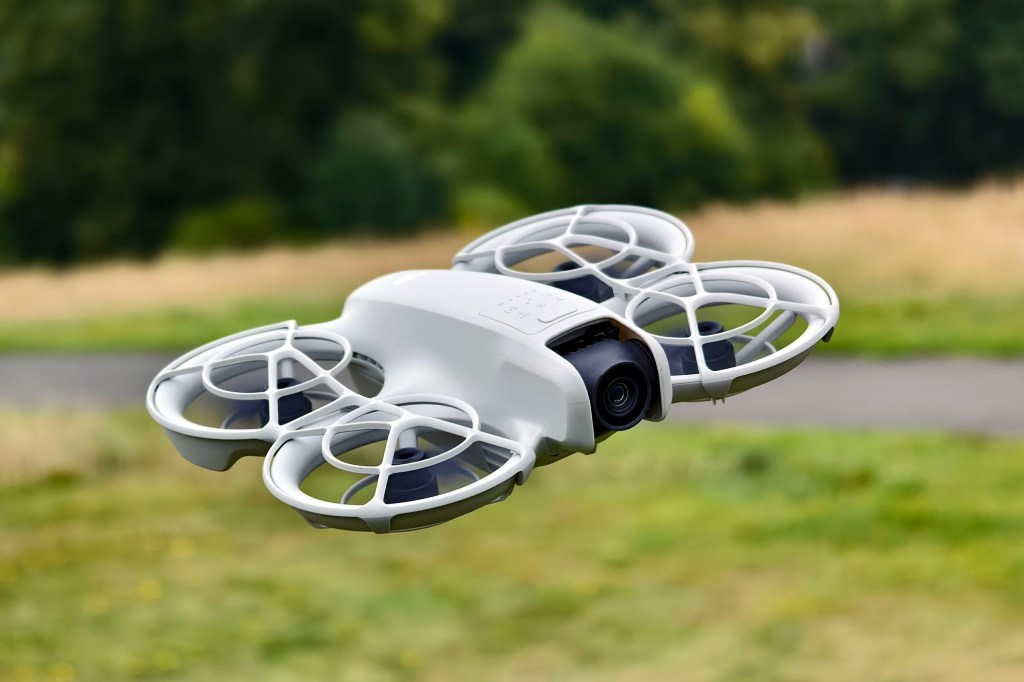
Amateur Photographer verdict
DJI was facing competition in the cheap drone arena, but it has fired back with the super-affordable Neo, which offers solid image quality and many (not all) of DJI’s intelligent flight features.- Fantastic value
- Effective stabilisation for stills and video
- 90° downward angle for overhead shots
- 22GB built-in storage
- Quality suffers in poor light
- Short battery life
- No card slot to expand storage
At a glance:
- Weighs less than 249g
- 12MP 1/2-inch CMOS sensor
- 4K video recording at up to 30p
- 13.9mm equivalent f/2.8 lens
- 1-axis gimbal
- www.dji.com
Drones are generally expensive, but cheaper options exist too — even from the major manufacturers. Case in point, the DJI Neo, a miniature drone released to compete with the many aggressively low-priced consumer drones that have flooded the market. At a minimum price of $199 / £169 without a controller, the Neo is the most wallet-friendly drone the firm has ever produced.
Of course, there is always such thing as too good to be true when it comes to cheap photo or video gear, but in our testing, the DJI Neo impressed, producing decent-quality images from its 12MP sensor, as well as solid 4K 30p video. Sure, the stills don’t hold up to cropping and zooming as well as those from pricier drones, and the video isn’t as buttery smooth as the 100p 4K on other models, but for the price, it’s impressive stuff. Frankly, we’d consider its price reasonable for a 12MP, 4K-capable camera even if it didn’t fly.
But this one does. And what’s more, you get lots of DJIs intelligent auto-flight features, including Follow (Tracking), Circle, Rocket (flying directly upwards), Spotlight and more. These give you easy, straightforward ways to introduce dynamic movement into your drone shots, which is ideal for anyone who’s just starting out with aerial video.
The inevitable cutbacks and compromises that come with a cheap drone are worth taking into account here. The image quality from the Neo is good in daylight, but is compromised quickly once light levels get low, due to the small sensor. Battery life is quite short — if you’re planning a big day, best pack a couple of spares — and while 22GB internal storage is nice, it’s annoying that there’s no option to expand it by inserting a microSD card.
Best sub-250g drone
Best sub-250g drone: DJI Mini 4 Pro – $759 / £869 with RC-N2 controller
Amateur Photographer verdict
Easy to fly, has great stabilisation and delivers exceptional quality images and footage from all three cameras.- Regulation-friendly flying
- Excellent 4K video
- 12 or 48MP stills
- Not robust
- Propellers a screw-fixed rather than bayonet fit
- No lens hood so flare can be an issue
At a glance
- Weighs less than 249g
- 12/48MP 1/1.3-inch CMOS sensor
- 4K video recording at up to 100p
- 24mm equivalent f/1.7 lens
- 3-axis mechanical stabilisation
- www.dji.com
Weighing less than 249g means that the Mini 4 Pro is regulation-friendly and can be flown in residential, recreational and industrial areas, and even over people (but not crowds) – provided you have Flyer and Operator ID’s from the CAA, and the relevant TRUST certification in the US.
Thanks to its 12/48MP 1/1.3-inch CMOS sensor, the Mini 4 Pro captures better quality stills and video than the DJI Mini 3. It’s sensor also has a quad-Bayer design which means that each of its 12-million-pixels are split into four sections that can report separately to deliver 24MP images, or they can combine to give 12MP images.
Just like the Mini 3 Pro, the standard Intelligent Flight Battery that comes with the drone allows up to 34 minutes of flying. Interestingly, DJI has ditched the 2.7K video option that’s available with the Mini 3 Pro but Full HD recording is still possible up to 60fps (200fps in SlowMo mode)
The Mini 4 Pro now features an updated omnidirectional obstacle avoidance system, which is especially useful when flying under tree branches or bridges. Just like its predecessor, it’s also prone to drifting in the breeze, but the stills and video are impressively good for such a small drone.
Read our DJI Mini 4 Pro review
Best first drone
Best first drone for photographers: DJI Mini 3 – $419 / £339 with RC-N1 controller
Amateur Photographer verdict
A capable, affordable drone for beginners, the Mini 3 makes for a great first-time buy. It produces excellent image quality in both RAW and JPEG, and boasts some useful automated flying features.- Sub-250g weight
- Excellent stabilisation and 4K video
- Affordable
- No object-avoidance sensors
- Drifts in a light breeze
- Screwdriver required to change propellers
At a glance
- 12/48MP 1/1.3-inch CMOS sensor
- 24mm (equivalent) f/1.7 lens
- 4K video at up to 30p
- Max flight time 38 minutes (claimed), 30 minutes (tested)
- <248g
A refresh of DJI’s budget-friendly drone, the Mini 3 ticks plenty of boxes for a first drone. First and foremost, it weighs less than 250g, so there’s no need to worry about licensing or certification (assuming you’re in the US or the UK, anyway). It’s also quite sensibly priced when bought with a RC-N1 controller – it can be bought for less without one, but we’re guessing that a lot of people who buy the Mini 3 will need a controller too.
It also uses the same high-end camera system as the pricier Mini 3 Pro, so you get a 48MP 1/1.3-inch CMOS sensor sitting behind a 24mm equivalent lens with an f/1.7 maximum aperture. The high resolution gives you a good amount of latitude for cropping into your images, while the large aperture helps with clarity of pictures in low light. Good stuff across the board. It lacks an object-avoidance system, as well as the smart subject-tracking features of the more deluxe models – but ultmately, the cutbacks had to come somewhere, and DJI has done a good job of making this an affordable drone that’s well kitted-out for beginners.
In testing, we found we were able to consistently capture good-looking images, with JPEG files in particular producing a punchy level of colour and contrast. RAW files take a bit of work to look their best, but this is par for the course, and they’re a good option if you want to avoid over-saturation. Video, of course, looks excellent, with 4K 30p footage that’s crisp and clear. DJI’s 3-axis stabilisation works brilliantly too, giving airborne footage a professional-looking smoothness.
Best mid-range drone
Best mid-range drone: DJI Air 3 – $1,099 / £869 with RC-N2 controller
Amateur Photographer verdict
Bringing the Mavic’s dual-camera setup to the mid-range Air series for the first time, this enthusiast’s drone comes with a price hike, but makes for a great step-up into serious aerial shooting.- Highly capable dual-camera setup
- Superb stills and 4K video quality
- Excellent ActiveTrack and obstacle avoidance
- Weighs more than 250g
- Vertical video mode is just a crop
- Pricey compared to Mini 3 Pro
At a glance
- Dual 48MP 1/1.3in type sensors
- 24mm (equivalent) f/1.7 wide-angle, 70mm (equivalent) f/2.8 telephoto with 3x optical zoom
- 4K video at up to 100fps
- Max stated flight time 31 minutes
- 720g
With the Mavic series sitting at the top of the DJI range, and the Mini drones filling out the entry-level positions, the Air series occupies something of a middle ground. They’re ideal ‘step-up’ drones for anyone who’s got a taste for aerial image-making with a smaller and cheaper drone and is looking for something more advanced, and the DJi Air 3 really leans into that role. It inherits the dual camera setup from the Mavic series, sporting two 48MP sensors, one of which is kitted out with a wide-angle lens, the other with a mid-telephoto 70mm equivalent lens.
Both cameras are of course mounted on a three-axis gimbal for superlative stabilisation. They have fixed apertures — f/1.7 for the wide-angle, f/2.8 for the telephoto — and together produce images of brilliant quality. For the utmost in detail you can use the full 48MP resolution, or you can set it to produce a downsampled 12MP image that’s more readily shareable and requires less work in post-processing. Video-wise, you’ve got crisp 4K in 10-bit colour at your disposal, at a maximum frame rate of 100fps, and a D-Log profile option for colour grading. There’s also a vertical video option in 9:16 for sharing to platforms like TikTok or Instagram Reels, though since this is really just a crop into the centre of the standard footage, it’s a bit of a stretch to call it a ‘mode’.
It’s an expensive proposition, especially compared to the Mini 3 Pro. However, the DJI Air 3 is a very impressive drone in its own right, and the additional telephoto camera does give you a lot more versatility in terms of the kinds of images you can make.
Best toy drone
Best toy drone: Ryze Tello – $99 / £99
Amateur Photographer verdict
If you are completely new to flying drones and just want to get some practice, the Ryze Tello is a great budget option- Incredibly cheap
- Very light (meaning it isn’t subject to regulations)
- Max 720p video
- Pack an extra battery!
At a glance
- 5MP 1/1.28-inch type sensor
- 23mm equivalent
- 720p video at up to 30p
- Max flight time 13 minutes
- 80g
It may not be the most feature-rich drone but the Ryze Tello uses DJI technology and costs around $100 / £100. This makes for an ideal taster drone for oneself without breaking the bank and/or you want to give the kids a taste of being a pilot.
Ryze doesn’t include a controller in the basic kit, that’s extra, but you can fly it using the Tello app on your phone.
With a 5MP camera on board and video limited to 720p, the Tello isn’t for serious use, but weighs just 80g, so you have the freedom to fly it almost anywhere. As usual, you can extend its 13-minute flight time with extra batteries and it’s ideal for getting aerial shots on holiday and having fun at the park or in your back garden.
How to choose the best drones with cameras
As camera drones tend to be quite similar in terms of specifications, picking the right one tends to be a matter of balancing features and price.
Higher priced drones will have better battery life, which means longer flight times. They also often can shoot video at higher resolutions and frame rates, and may also have sophisticated features like omni-directional object avoidance sensors and image stabilisation for getting smooth footage even in choppy, windy conditions.
Another thing to bear in mind though is that all these features don’t just make the drone more expensive: they also make it heavier, which as we’ve seen, can mean you need a licence to fly it.
Brand-wise, DJI is the dominant force in the drone market and each year it brings out increasingly sophisticated models that promise to enable you capture better images more easily than before. It’s not the only player though, so we have included the best non-DJI drone in this guide to allow you to compare. So let’s take a looks at our choice of the best drones with cameras this year.

Drone weight and the law: what you need to know
For most people, the simplest way to get up and running, without additional expense or worry, is to look for a drone under 250g / 0.55lbs, as there are stricter rules for drones that weigh more than this. This is not very much in terms of weight – a bag of microwave rice generally weighs about 250g. However, drones are typically constructed from extremely lightweight materials, so you can get quite a sophisticated drone that still comes under this limit.
In the US you’ll need certification called TRUST, for recreational flying of drones under 250g. Luckily this is simply an online test that takes around an hour to complete. You can find more information on the FAA website. If your drone weighs over 250g (0.55lb), then you’ll need to register your drone with the FAA, on the FAADroneZone site.
In the UK you’ll want a a sub-250g drone if you don’t have a licence, and you will need to get a Flyer ID and Operator ID from the CAA to fly a drone over 250g.
If you’re located elsewhere, or travelling to a different location, make sure you check local restrictions as they may differ!
Once you have your licence / certification, you’re able to fly a drone in most places, apart from in the flight restriction zones around airports, military bases and prisons etc. You can even fly over people as long as there isn’t a crowd.
How we test camera drones
We test camera drones in much the same way we would test any other camera — by using them to take photographs and video in a wide range of real-world situations. We evaluate their control layouts and handling, as well as their automated flight features, to determine how easy they are to control and achieve good-looking results with. We look at flight times and how they measure up to the manufacturers’ claims.
We also examine the effectiveness of their image stabilisation systems — critically important when looking at drones. Last but by no means least, we critically evaluate the image quality, in both JPEG and raw, including resolution, high-ISO noise, and dynamic range. We then take all these factors into account, along with such things as portability and lens systems, when giving our final conclusion and score. You’ll find the full breakdown of how each camera has performed in our full reviews.
Related reading:
- How to edit an engaging FPV drone video
- Capture your best aerial photos and videos with a drone
- DJI Mini 4 Pro: new lightweight drone released
If you’d like more help in choosing a great camera or lens, have a look at our latest reviews, and buying guides.


